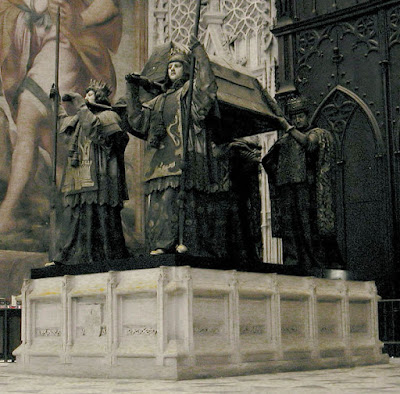 Inside the cathedral in Sevilla
Inside the cathedral in SevillaThe first time I went into the famous cathedral in Sevilla, we were going to mass. Simply walking into the cathedral is a bit stupefying. It’s HUGE. It’s also incredibly ornate. The wall behind the altar has dozens of carved, painted and gilded panoramas from Biblical literature. Apparently some people are under the impression that the more ornate the cathedral, the more pleasing it is to God.
 Just a tiny snapshot of the immense altar
Just a tiny snapshot of the immense altarSpain is famously – and notoriously – Catholic. The history and cultural traditions of Spain are deeply Catholic, even though a small percentage of the population goes to mass each week.
 Iglesia de Salvador, downtown Sevilla
Iglesia de Salvador, downtown Sevilla A spectacular ceiling inside the cathedral in Toledo
A spectacular ceiling inside the cathedral in ToledoUnder Franco, the fascist dictator who ruled Spain for decades (until 1975), Catholicism was the state religion. Children could not even enroll in school without a Saint’s name. (One reason there are so many Marias and Ignacios in Spain.) Franco designed and constructed a large tomb for himself which also functions as a memorial for those who died fighting for him in the Spanish Civil War. We saw this tomb, out of our bus window, on our way to Segovia from Madrid. The cross at this site is the tallest memorial cross in the world.
The Franco period in Spain is quite controversial and I have no authority to comment on it. Depictions of Franco and the Spanish civil war can be found in countless works of art, literature and films.
Catholicism fascinates me and I obviously love the Jesuits since I’ve been working for them for 4 years. I have a great deal of respect for the Jesuit emphasis on critical thinking and social justice. I also appreciate the emphasis on generosity, humility and community service in the Catholic Church.
 The virgin on the exterior of a church in Sevilla – this is very common here
The virgin on the exterior of a church in Sevilla – this is very common hereMass at the cathedral was quite different than any mass I’ve attended. I felt distanced from the service because of the language barrier, the physical distance of 30 feet in between the congregation and the altar and the fact that I’m not Catholic. There was no music during the mass, the bishop’s homily was too old fashioned and they didn’t have wine with communion – what’s up with that?
 At mass, I happened to look to my right and this is what I saw: the tomb of Columbus!
At mass, I happened to look to my right and this is what I saw: the tomb of Columbus!This week, we attended a service at one of the 2 Anglican churches in Sevilla. Iglesia de San Basilio was lovely. The small church is decorated simply – no weeping virgins or bleeding Christs. Above the altar was a simple wooden cross.
We arrived a few minutes early and chatted with the one and only priest for a while. He found us 2 worship service books with an English translation from the Book of Common Prayer. The service was the same Episcopal service we’re used to – just in Spanish.
The congregation included about 25 other parishioners, most of whom were over 65. The church wasn’t that different than any other tiny church. There was the one woman who sings really loud and a little flat. The priest introduced Brad and me by name before the end of the service. And, after church, we were greeted by several friendly parishioners, one of whom gave us some café con leche.
During the passing of the peace, the priest went to each parishoner in attendance; he gave the women kisses on our cheeks and shook the men's hands. Loved it! Everyone said, “La paz contingo,” (Peace be with you.)
The music at the service brought me joy. As the first chords of the first hymn played on the keyboard, I instantly recognized the tune: Praise Ye the Lord, the Almighty. I printed a verse of this hymn in our wedding program.
Praise Ye the Lord, who o'er all things so wondrously reigneth,
Shelters thee under His wings, yea so gently sustaineth!
Hast thou not seen, how thy desires e’er have been,
Granted in what He ordaineth?
The final hymn was another familiar tune: The Church’s One Foundation. It’s pretty to cool to sing these in Spanish. It’s also nice to take communion after a month . . . my sins were starting to pile up.




























